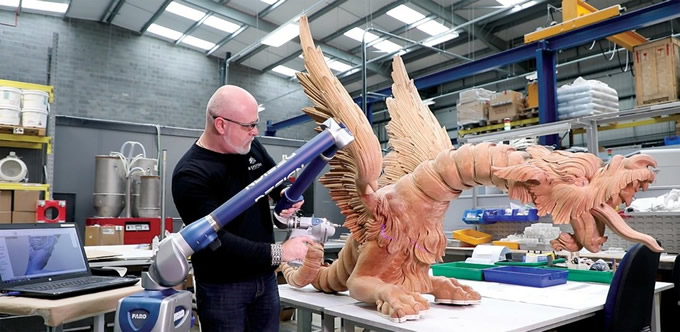3D Systems Helps to Bring 250-Year Old Dragons Roaring Back to Life
3D Systems (NYSE: DDD) today announced the installation of 72 large-scale 3D printed dragons at The Great Pagoda at Kew (UK) – the final elements required to complete the Historic Royal Palaces (HRP) restoration of this 250 year old UNESCO World Heritage site.

The Great Pagoda at Kew was commissioned in 1761 in the midst of the reign of King George III. In the years following the Pagoda's unveiling, it drew crowds who came to marvel at its exotic and eye-catching details – including the painted wooden dragons that adorned the octagonal corners of each successive level. In the 1780s, the dragons were removed to accommodate roof repairs and were never replaced. Although rumors allege the dragons served as payment for royal gambling debts, experts believe the wood had simply rotted over time.
As HRP began the project, it needed a way to replace the large dragons that once adorned the building but were lost to history. HRP required a solution that would authentically replicate the dragons, yet could withstand the famously inclement English weather. 3D Systems' On Demand Manufacturing team (High Wycombe, UK) delivered the lightweight, durable dragons using a scan-to-CAD workflow featuring Geomagic® software, Selective Laser Sintering (SLS) 3D printing and high quality finishing. These technologies, combined with the expertise 3D Systems' team demonstrated through many hours of front-end engineering and back-end finishing, made this effort manageable, efficient and cost-effective.
"We turned to 3D Systems to provide the rapid throughput, accurate details, and excellent finishing that was needed for this project," said Craig Hatto, project director, Historic Royal Palaces. "The engineering skill of 3D Systems' team, the opportunity to light-weight the dragon statues, and the material longevity of SLS 3D printing were key considerations for this project."
Bringing the dragons back to life required a unique combination of research and reverse engineering by the company's On Demand Manufacturing team to enable rapid digital production of the parts. The project involved scanning a wood-carved dragon with the FARO® Design ScanArm into 3D Systems' Geomagic® Design X reverse engineering software. The use of CAD enabled, innovative engineering solutions for the dragons, including hidden features to facilitate mounting them to the pagoda as well as a much lighter-weight, hollowed statue that is 60% lighter than wood alternatives. The significant weight reduction enabled by 3D printing ensures less stress is placed on this historic building, helping to preserve it for the future. The 3D Systems' team also used the CAD data to scale the dragons, producing them in a variety of sizes from 1150mm to 1850mm in length.
"In 3D printing, we are not limited by the need or time required to wait for tooling," said Nick Lewis, general manager, on demand manufacturing, 3D Systems. "The existence of digital 3D data gives us freedom to produce parts rapidly, and with custom sizes."
The dragons were printed on 3D Systems' SLS machines in DuraForm® PA, a durable polyamide 12 nylon material capable of producing a look and feel comparable to the original dragons. The resolution and mechanical properties of DuraForm PA make it an ideal candidate for complex parts with thin walls or snap fit requirements. In the case of the Kew dragons, these features suited both the functionality requirement of installation as well as the cosmetic requirements of the historic restoration. The 3D printed dragons were finished by 3D Systems' skilled artisans who hand-painted each piece.
"We so often see 3D printing technology applied to new innovations that when we get the chance to literally make history, it is quite exciting," said Phil Schultz, senior vice president and general manager, plastics and on demand manufacturing, 3D Systems. "In this collaboration with Historic Royal Palaces, we were able to bring new technology to bear on a historical landmark – restoring it to its former beauty and helping to ensure its future for generations to come. It's a testament to the capabilities and expertise of our On Demand Manufacturing team. Our full suite of durable materials, 3D printing technologies, reverse engineering software and practical expertise allow us to create a custom solution no matter how unique the customer's needs."
The Great Pagoda at Kew opens to the public on July 13, 2018. Please visit the company's website to learn more about this historic restoration, or the company's On Demand Manufacturing.
About 3D Systems
3D Systems is the originator of 3D printing and an innovator of future 3D solutions. It has spent its 30-year history enabling professionals and companies to optimize their designs, transform their workflows, bring groundbreaking products to market and drive new business models. This is achieved with the Company's best of breed digital manufacturing ecosystem. It's comprised of plastic and metal 3D printers, print materials, on demand manufacturing services and end-to-end manufacturing software solutions. Combinations of these products and services address a variety of advanced applications- ranging from Aerospace, Automotive, and Consumer Goods to Medical, Dental, and Jewelry. For example, 3D Systems' precision healthcare capabilities include simulation, Virtual Surgical Planning, and printing of medical and dental devices as well as patient-specific surgical instruments. More information on the company is available at www.3dsystems.com.
Comments (0)
This post does not have any comments. Be the first to leave a comment below.
Featured Product

